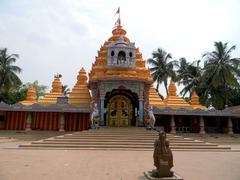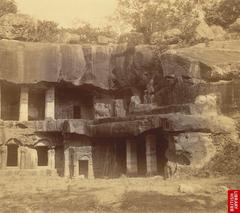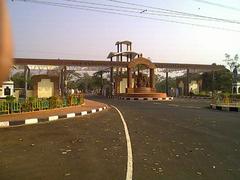Yameshwar Temple Visiting Hours, Tickets, and Bhubaneswar Historical Sites Guide
Date: 04/07/2025
Introduction to Yameshwar Temple
Situated in Bhubaneswar, the revered “City of Temples,” Yameshwar Temple is a unique spiritual and architectural gem. Unlike the city’s more famous Shaivite shrines, Yameshwar Temple is dedicated to Yama, the Hindu god of death and justice—a rare dedication in the Indian religious landscape. With its roots tracing back to the medieval era under the Somavamshi and Eastern Ganga dynasties, the temple exemplifies the signature Kalinga architectural style, featuring a curvilinear spire (rekha deul), detailed sandstone carvings, and a sanctum rich in sacred iconography (Discover Bhubaneswar; Tripcrafters; Indianetzone).
Serving as a focal point for rituals related to death, ancestral worship, and cosmic balance, Yameshwar Temple holds immense spiritual significance, particularly during observances such as Pitru Paksha and Yama Dwitiya (Stamped Moments; poojn.in). Its proximity to Bindusagar Lake and location within Bhubaneswar’s Old Town make it a key stop on the city’s heritage circuit. This comprehensive guide explores Yameshwar Temple’s history, architecture, rituals, visitor information, and its place among Bhubaneswar’s historical sites.
Contents
- Historical Background
- Origins and Construction
- Architectural Features
- Religious and Cultural Context
- Visiting Hours and Ticket Information
- Accessibility and Visitor Tips
- Nearby Attractions
- Rituals, Festivals, and Community Life
- Conservation Status
- FAQs
- Conclusion
- Sources
Historical Background
Origins and Construction
Yameshwar Temple is believed to have been constructed between the 10th and 14th centuries CE, during a prolific era for temple building in Odisha under the Somavamshi and Eastern Ganga dynasties (Discover Bhubaneswar). It stands near Bindusagar Lake in the Old Town, an area that forms the core of Ekamra Kshetra—Bhubaneswar’s ancient sacred precinct (TravelSetu).
Architectural Features
Yameshwar Temple is a classic example of Kalinga architecture:
- Vimana (Sanctum Tower): Built in the rekha deul style, the spire is tall and curvilinear, topped with an amalaka and kalasha.
- Jagamohana (Assembly Hall): Features a stepped pyramidal roof (pidha deul), used for congregational worship.
- Decorative Sculptures: The temple’s sandstone exteriors are adorned with images of deities, floral motifs, guardian figures, and mythological scenes. Unique features include depictions of Yama and symbolic carvings related to the themes of mortality and justice.
- Material: The main structures are built from local sandstone, while the outer prakara (enclosure) utilizes laterite for durability (Indianetzone).
- Sanctum: Houses a shivalinga set in a circular yonipitha, with additional representations of Yama in relief.
Religious and Cultural Context
Yameshwar Temple’s dedication to Yama sets it apart from Bhubaneswar’s predominantly Shaivite landscape. Yama, as the god of death and dharma, is central to Hindu cosmology—his presence here highlights the city’s inclusive spiritual ethos and offers a space for rituals surrounding death, ancestral remembrance, and the quest for liberation (poojn.in).
Visiting Hours and Ticket Information
- Opening Hours: Daily from 6:00 AM to 8:00 PM.
- Entry Fee: Entry is generally free; some sources mention a nominal fee for foreigners, but for most visitors, there is no ticket required (Discover Bhubaneswar).
- Photography: Allowed in outer areas; always check signage and respect rituals, especially inside the sanctum.
Accessibility and Visitor Tips
- Access: The temple is moderately accessible. While paved paths lead to the entrance, some areas have uneven stone flooring. Assistance is available, especially during festivals.
- Best Time to Visit: October to March offers pleasant weather. Early mornings or late afternoons are ideal for a peaceful experience.
- Getting There: Located centrally in Old Town, the temple is easily reached by auto-rickshaw, taxi, or city bus from Bhubaneswar Railway Station (~5 km away).
- Dress Code: Modest clothing is advised. Shoes must be removed before entering temple premises.
- Facilities: Restrooms, drinking water, and offerings stalls are available nearby.
Nearby Attractions
- Lingaraj Temple: The city’s most prominent Shaivite shrine.
- Mukteshwar Temple: Renowned for its intricate stonework and archway.
- Bindusagar Lake: Sacred water body central to many rituals.
- Rajarani Temple: Noted for its unique red and yellow sandstone architecture.
- Odisha State Museum and Ekamra Haat: For art, culture, and local crafts.
Many heritage walks and temple tours include Yameshwar Temple in their itineraries, offering a deeper historical perspective (Tripcrafters; Stamped Moments).
Rituals, Festivals, and Community Life
Major Festivals
- Maha Shivaratri: The grandest festival, with night-long prayers, abhisheka of the shivalinga, and special cultural programs (poojn.in).
- Yama Dwitiya (Bhai Dooj): Special prayers to Yama for sibling welfare and protection from untimely death.
- Pitru Paksha: Period of ancestral rites performed for the liberation of departed souls.
Daily Rituals
- Mangala Aarti: Early morning worship.
- Abhisheka: Ritual bathing and adornment of the shivalinga.
- Evening Aarti: Concludes the day’s worship with lamps and hymns.
Community and Cultural Events
During festivals, the temple hosts classical dance, music, and community feasts (anna dana), fostering social harmony. Volunteers assist with crowd management and prasad distribution, and the temple’s priests maintain ritual traditions (orissaguide.com).
Conservation Status
Yameshwar Temple is a protected monument under the Archaeological Survey of India. While the sandstone carvings are vulnerable to weathering, ongoing restoration ensures the temple’s preservation for future generations (Discover Bhubaneswar). The laterite prakara has endured well, and periodic repair work addresses structural concerns.
Frequently Asked Questions (FAQs)
Q: What are the temple’s visiting hours?
A: 6:00 AM to 8:00 PM daily.
Q: Is there an entry fee?
A: Entry is free for most visitors; foreigners may pay a nominal fee.
Q: Is photography allowed?
A: Permitted in outer precincts. Inside the sanctum, seek permission.
Q: Is the temple accessible for differently-abled visitors?
A: Moderately accessible; assistance is available, especially during festivals.
Q: Are guided tours available?
A: Yes. Local guides and travel agencies offer heritage walks including Yameshwar Temple.
Q: What is the best time to visit?
A: October to March, particularly during major festivals.
Conclusion
Yameshwar Temple encapsulates Bhubaneswar’s spiritual depth and architectural legacy. Its rare dedication to Yama, active ritual calendar, and integration within the city’s heritage circuit make it an essential destination for pilgrims, history enthusiasts, and cultural travelers alike. Plan your visit to explore not only the temple but also the broader spiritual and historical landscape of Bhubaneswar. For guided tours, festival updates, and travel tips, download the Audiala app and stay connected for an enriching journey.
Image Suggestions:
- Exterior view of Yameshwar Temple (alt: “Yameshwar Temple Bhubaneswar exterior view”)
- Close-up of Kalinga-style carvings (alt: “Kalinga architecture carvings at Yameshwar Temple”)
- Map showing Yameshwar Temple and nearby attractions in Old Town Bhubaneswar
Internal Links:








